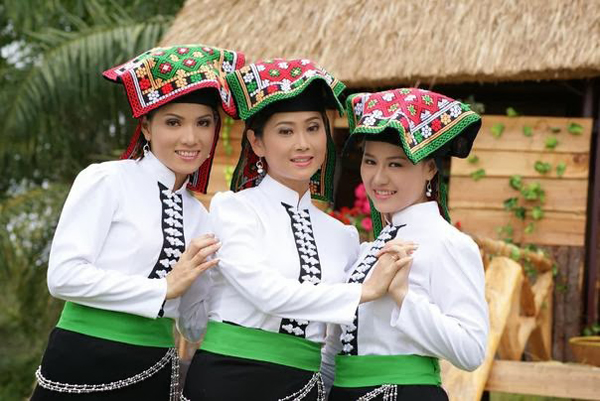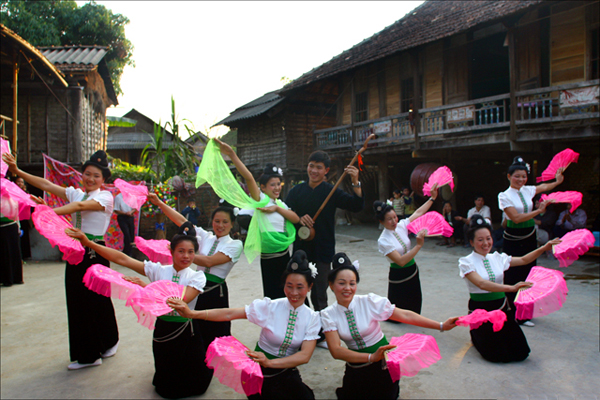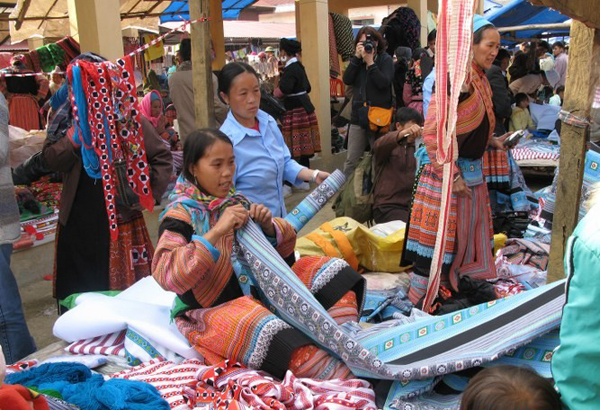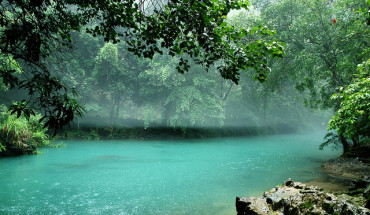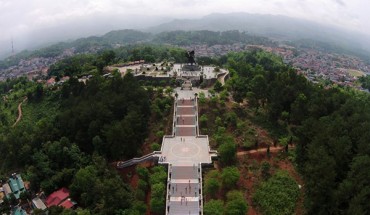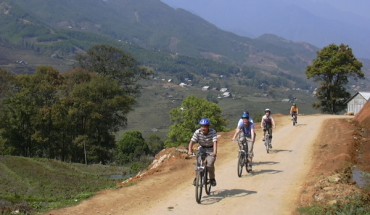The Thai
Collectively, the Thai belong to the Austro-Asiatic language family and specifically to the Tay-Thai language group. Their ancestors migrated south from southern China at an early date and had set up numerous petty kingdoms in the region as early as the first millennium CE. By the 13th century the Thai had established unchallenged supremacy over other ethnic groups in the region; the subsequent history of north west Vietnam is dominated by the rivalries between its powerful Black and White Thai lordships and the not insignificant military efforts required of successive Viet kings to bring them under central control.
Ancient patterns of Thai settlement still pertain today throughout north-west Vietnam; the Black Thai are concentrated mainly in Son La, Yen Bai and southern Dien Bien Provinces, while the White Thai are to be found predominantly in northern Dien Bien, Lai Chau, Yen Bai and northern Son La Provinces, with distinct sub-groupings further south in the Hoa Binh, Thanh Hoa and Nghe An Provinces. With a combined population of 1, 328, 725 (1999 census), the Thai constitute the second largest ethnic minority in Vietnam.
Traditionally the Thai community was organised into townships known as muong, each with their own administration and social structure, which were ruled over by a tao or chief drawn from one of the aristocratic families (Bac, Cam, Ha, Hoang, Lo, Vi, Deo). From the 16th century onwards the 12 most important Thai townships – including both Black and White Thai muong-grouped themselves together into a loose political federation known as Sipsong Chutai (12 muong), of which at any given time the strongest chief was nominated supreme leader and his muong the capital of the federation. Between 1889 and 1954 the Deo White Thai chieftains of Muong Lay secured the formal recognition of the French colonial government as hereditary supreme leaders of Sipsong Chutai in exchange for their support as colonial governors of the entire North West region.
Today the Thai live in river valleys in villages varying in size from 30 to 100 houses. These houses are constructed using wooden frames joined by tendons with no nails or screws. Thai architecture varies considerably from region to region, with clear differences between those of the White and Black Thai.
White Thai houses in Hoa Binh, Thanh Hoa and Nghe An are rectangular in shape and feature a deep thatched or tiled hipped and gable-ended roof, wooden walls, a front corner entrance stairway and a relatively large number of windows, each of which is decorated with small fences. Those further north in Dien Bien, Lai Chau, Yen Bai and northern Son La Provinces are closer in design to those of the Black Thai, incorporating a railed balcony along the complete length of the side of the house and a drying platform and/or outhouse at one end of the building; walls are often made from bamboo panels rather than wood. The interior layout in a White Thai house is on one level and generally open-plan.
In contrast, the typical Black Thai house found throughout Son La, Yen Bai and Dien Bien Provinces generally features bamboo walls with relatively few windows and a thatched roof shaped like a tortoise shell with decorations known as khao cut at the end of each ridge; in recent decades the older tortoise-shell roof has been replaced in many areas by a rectangular-shaped thatched or tiled roof. The main entrance stairway usually leads into the house via a large drying platform and/or outhouse at one end of the building, and a railed balcony is often found along the front and side of the house. The interior layout in a Black Thai house usually incorporates a raised platform for sleeping which stretches the full length of the main living (quarters, plus partitioning to separate other areas.
The Thai cultivate wet and rice along the valley floors, but also grow sweet potato, maize, manioc, tobacco and some indigo and cotton on the lower altitude slopes. The Thai believe in a wide range of spirits, collectively known as pi. Each house has an ancestral altar where the spirits of the ancestors are thought to live, and where annual ceremonies are conducted to honour them. If there is sickness or a special need, other ceremonies are held to ask the spirits for help. There are distinct differences between the White and Black Thai dialects; according to academics at Chulalongkorn Institute of Thai Studies in Bangkok, the dialect spoken by the Black Thai is relatively close to that of Laos and north eastern Thailand (Isaan).
Both White and Black Thai once had their own scripts, and although these are no longer in use today, a number of important historic texts have survived (several of which are held by Son La Provincial Museum, see p 126), including the Black Thai epic poems Xong chu xon xao and Khun Lu Nang Ua. Furthermore a rich tradition of legends and humorous tales continues to be handed down orally from generation to generation.
An important performing arts heritage is preserved by both Black and White Thai ethnicities. Best- known is the call-and-response genre known as khap, comparable to the luon of the Tay, the sli of the Nung and the lam of the Lao and Lu, which takes the form of a flirtatious male- female courting game in which young men and women engage in sung poetic dialogue, testing each others skills. There is also a large corpus of folk songs and a wide range of traditional folk dances, best-known of which is the xoe vong or circle dance, in which couples dance circles around one another until there are three circles in all – a circle danced by the individual, a circle danced by the couple, and a circle danced by the whole crowd. The xoe vong is danced to a slow rhythm and features delicate and precise movements of the hand. Musical accompaniment is usually provided on the bamboo pipe organ known as the khene, but performances can also be accompanied by ethnic minority instruments such as bamboo flutes or fiddles, or simply by hand clapping.
Weaving and embroidery are practiced widely amongst both White and Black Thai communities, although most of the raw cotton is now bought in rather than grown. Basket weaving and carpentry also feature amongst the handicraft activities of Thai communities throughout the region.
Thai women may be instantly recognised by their traditional clothing, which comprises a short coloured jacket (xua com) decorated at the front with butterfly- or bee-shaped silver buttons, a long black skirt and a coloured sash tied around the waist. However, there are numerous variations to this costume.
Most White Thai women wear a white or pale- coloured silver-buttoned jacket with a heart- shaped collar, although in recent years this is increasingly replaced by a standard white blouse. The traditional silver-buttoned jacket worn by Black Thai women is usually dark in colour and features a round collar.
An important distinguishing feature between Black Thai and White Thai women is that while most married White Thai women wear their hair down, married Black Thai women usually arrange their hair in a bun (thang cau) on top of their head, often with additional false hairs added to give bulk, and also cover their head with the distinctive Black Thai pieu headscarf, which is embroidered with intricate red and yellow designs
Throughout the region the traditional attire of Thai males usually features a plain black or dark- coloured shirt and trousers.
The White Thai (Thai Trang) of Mai Chau
The traditional costume of the White Thai women of Mai Chau and a number of other White Thai enclaves in Thanh Hoa and Nghe An Provinces differs from that of other Thai people throughout north west Vietnam, being rather closer in design to the traditional costume of the Muong. For women it usually comprises a long black skirt with fitted waist band embroidered with either a dragon or a chicken motif, together with a plain pastel-coloured blouse; an embroidered gold and maroon sash is also sometimes worn.
Hang Kia and Xa Linh Villages of the Flower M’mong ethnicity
Cac ban Hang Kia va Xa Linh cua dan toc Hmong Hoa Location: Huyen Mai Chau, Tinh Hoa Binh A two-day guided trek offered by many homestays takes travelers up in a north westerly direction from Lac and Pom Coong villages, climbing around 600 metres into the beautiful 7, 091-hectare Pa CO Hang Kia Nature Reserve, which was set up in 1986 for the conservation of limestone karst forest, gymnosperm species [and] rare wildlife. After an overnight stop in the Flower H’mong village of Hang Kia, travellers eventually reach the Flower Hmong village of Xa Linh, just south of National Road 6, where they are met. Since those doing this trek will need to arrange transport at the other end, it makes sense to schedule it at the end of your stay in Mai Chau so that you can continue straight on from Xa Linh to Son La.
The Hmong people living in and around the Pa Co Hang Kia Nature Reserve are the only members of their ethnicity to be found in Hoa Binh Province. Culturally, the Hmong are one of north Vietnams most interesting ethnic groups, and the costume of the Flower Hmong people of western Hoa Binh Province and eastern Son La Province is subtlely different from that of the Flower Hmong further north:
The Hmong
The Hmong, often known by the pejorative name Meo, constitute the eighth largest ethnic minority in Vietnam with a total population of 787, 604 (1999 census). Belonging to the Austro-Thai language family and specifically to the Hmong- Mien language sub family, they migrated from southern China into Vietnam, Laos and northern Thailand along with their Dao cousins at various stages during the course of the last 300 years. The Hmong are settled widely across the north of Vietnam, but are most densely grouped along the Lao and Chinese border area.
Of the four Hmongic language branches of Hmong- Mien found throughout the wider region, three – Chuanqiandian (Western Hmongic), Qiandong (Central Hmongic) and Xiangxi (Northern Hmongic) are represented in Vietnam.
The Chuanqiandian (Western Hmongic) language branch comprises over 20 sub-branches, the largest and most important being the Central Chuanqiandian cluster which includes both the Hmoob Leeg/Hmong Leng or Flower/Variegated Hmong, known in Vietnam as Hmong Hoa, and the Hmoob Dawb/Hmong Daw or White Hmong, known in Vietnam as Hmong Trang. The Flower or Variegated Hmong constitute the largest Hmong group in Vietnam and the White Hmong the second largest, and their dialects are mutually intelligible. As in neighbouring Thailand and Laos, some Hmoob Leeg/Hmong Leng groups are occasionally known as Hmoob Ntsuab/Hmong Njua (Green or Blue Hmong). The Qiandong (Central Hmongic) language branch may be divided into eastern, northern and southern sub-branches; the southern sub-branch includes the Hmoob Dub/Hmong Dub or Black Hmong, known in Vietnam as Hmong Den.
The Xiangxi (Northern Hmongic) language branch may be divided into eastern and western sub-branches; the latter includes the Hmoob Si/ Hmong Si or Red H’mong, known in Vietnam as H’mong Do.
The dialects of the Black Hmong (Qiandong) and Red Hmong (Xiangxi) are not mutually intelligible with those of the Flower/Variegated Hmong and White Hmong (Chuanqiandian).
Like the Dao, the Hmong build their houses directly onto the ground rather than on stilts, following a rather basic design with a thatched roof and walls of either wood or bamboo. Interior design usually involves a simple open-plan layout, although the houses of some branches in the North West such as the Black Hmong of Sa Pa can be larger, incorporating partitioning and raised sleeping quarters. Hmong villages sometimes contain up to 150 houses, but are usually considerably smaller. Traditionally located mainly at mid to high altitudes, Hmong villages are now increasingly found along the river valleys and next to main roads, often as a direct result of government resettlement schemes designed to wean the Hmong away from slash-and-burn agriculture and particularly their traditional cultivation of opium on the higher mountain slopes.
Hmong communities resettled to lower altitudes cultivate mainly wet and dry rice and a wide variety of cash crops, including maize, sugarcane, manioc, peanuts, green bean, cucumbers and squashes, as well as fruits such as bananas, plums, peaches, apples and pears. In some areas such as Lao Cai Province where the Hmong have lived in river valleys for a long period of time, they have become adept at constructing terraced rice fields irrigated by a sophisticated system of canals. Homestay in Mai Chau
Hemp and indigo plants are also grown in and around most Hmong villages – the Hmong use the strong fibers of the hemp to make their clothes and the indigo leaf (la cham) to produce the deep blue dye which colors them. A few villages still raise silkworms to make thread for their exquisite embroidery, which features on the costume of virtually every member of the community from the youngest baby to the aged.
Hmong people are renowned for their craft production, which includes fine silver and bronze jewellery, basket ware and decorative bark cloth. They are also renowned as excellent horsemen and are particularly skilled at making horse-riding tackle.
Other traditional crafts practiced in Hmong villages include the brewing of traditional medicines using forest leaves and the creation of ochre-colored incense from tree bark.
The Hmong worship their ancestors and numerous animist spirits such as the spirits of the mountain, the forest and the rice harvest. Some villages still have their own shaman, who acts as the intermediary with the spirit world.
The Hmong language remains the principle means of communication in Hmong settlements. It remained oral in its various dialects until the 1930s, when a French priest attempted to romanise it with a view to translating the Bible. A more successful attempt to create a written Hmong language using the phonological system of the Black Hmong of Sa Pa district was made in 1961; however, this system has since fallen into disuse, and today only a few old people remember how to write in the roman script. Nonetheless, the H’mong people still preserve an extraordinarily rich oral tradition of legends, stories and histories. Hmong people are renowned for their folk songs, which are quite unique. Each branch of the Hmong people preserves its own corpus of love songs, work songs and festival songs, which can be presented either solo or accompanied by the special Hmong version of the khene (bamboo pipe organ), a two-stringed violin known as a go lung jia, flutes, gongs, drums and jews harps. Numerous Hmong dances also exist to celebrate various dates in the social calendar and to propitiate animist spirits.
The Hmong display remarkable regional variation III traditional costume, a common feature of most branches being the women’s pleated indigo batik skirt with richly-embroidered border. In addition to the Flower Hmong (Hmong Hoa), travelers on this circuit will also encounter their close cousins the White Hmong (Hmong Trang), as well as the Red Hmong (Hmong Do) and the Black Hmong (H’mong Den). The traditional clothing of each of these Hmong branches has certain characteristic features – for instance, the White Hmong may usually be identified by the concentric blue bands on the upper sleeves of their shirts. However, there are also marked differences in the traditional costume of the White Hmong in one district and that of the White Hmong in another, and this also applies to the Red and Flower Hmong people. Indeed, such is the variation from area to area that even experts on ethnic minority cultures sometimes have problems trying to identify which branch of Hmong they have encountered! Hmong men generally wear a combination of black trousers and black jacket; the latter occasionally embroidered at the sleeves or cuffs. As with the Dao ethnicity, the most delicate embroidery is reserved for the clothing of babies, and young children of most branches of Hmong wear an embroidered bonnet with decorative tassels, coins or bells. The Flower Hmong (Hmong Hoa) of Mai Chau, Moc Chau and Yen Chau.
The Flower Hmong of Mai Chau, Moc Chau and Yen Chau Districts (western Hoa Binh and eastern Son La Provinces) form part of the Chuanqiandian (Western Hmongic)-speaking Hmoob Leeg/Hmong Leng community. The Flower Hmong of this area wear a much simpler costume than their namesakes in Lao Cai Province, which comprises an embroidered indigo batik skirt covered by a plain black apron, a black shirt with embroidered rings around the lower sleeves and black leg- warmers. Their hair is plaited and wound around the head and silver earrings and necklaces are worn. Male attire usually comprises a black shirt with embroidered rings around the lower sleeves and plain black trousers.


